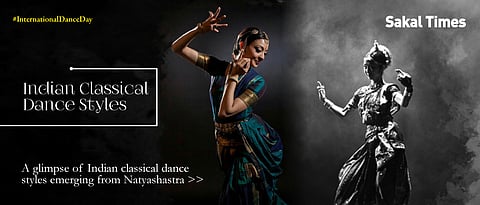

Today marks the celebration of International Dance Day. The day created by the International Theatre Institute (ITI) aims for global promotion of dance as an art form. Dance, being one of the oldest of art forms, is also a way of non-verbal communication using body movements, expressions, emotions, gestures which are used to describe a story.
A popular form of entertainment and nowadays even a popular method of burning calories through workout! Dance has been a fun way of expression and exercise.
In India, the classical dance forms are considered as an integral part of sacred rituals and traditions with its history dating back to the period of the Vedas, around 1000 BC.
Indian mythology also has mentioned various dance forms which were linked to the divine power and godliness. Today, on the occasion of International Dance Day, let’s take a look at Indian classical dance styles in India.
There are nine classical dances as recognised by Ministry of Culture, Government of India. They have emerged from Natyashastra, a Sanskrit text on performing arts written by Bharat Muni in 200 BC-200 AD. Most of the dance styles were originated from temples, and even though they came from various regions, their core root was the same.
Dance forms performed with beautiful and diverse styles were made from ‘Rasa’ or emotions. According to Natyashastra, Indian classical dance is based on eight fundamental emotions namely:
Shringar: Love
Hasya: Humorous
Karuna: Sorrow
Raudra: Anger
Veer: Heroism
Bhayanak: Fear
Bibhats: Disgust
Adbhoot: Wonder.
Later a ninth emotion, ‘Shanta’ or peace was added by Abhinavgupta, a distinguished philosopher and saint. A combination and variation of all these emotions are used to create a dramatic performance. The ‘Rasanubhuti’ or knowledge about various emotions lead to an effective way of storytelling through dance performances.
Many young children start to learn traditional classical dance styles at an early age, as it helps them gain proper discipline and training.
The nine classical dance styles are; Kathakali a religious dance from Kerala that draws inspiration from the Ramayana and stories of Shaiva traditions, Mohiniyattam which is the second most popular dance form in Kerala, was revived by locals in 1940 after its ban implemented by the colonial British Raj.
One of the oldest of the surviving Indian classical dances Odissi from Odisha; it replicates the postures found in temple sculptures with over 50 mudras, i.e. symbolic hand gestures.
Another dance style from Odisha is Chhau, a tribal dance which enacts the episodes from epics like Mahabharata and Ramayana, also including some local folklore and abstract themes. Chhau dance also has elements of martial arts. Kuchipudi from Andhra Pradesh is a dance form that requires talent in singing and dancing. It also includes a highly ritualised performance including a sprinkle of holy water, burning of incense and praying to the goddesses.
Introduced in the 15th century AD by Mahapurusha Sankaradeva, a Vaishnava saint and reformer of Assam, Sattriya from Assam is a dance form preserved in the Sattras or the Vaishnava maths. It is an artistic way to present mythological teachings. Bharatanatyam from Tamil Nadu is a dance style originally performed in temples to express Hindu religious stories and devotions; it uses movements characterised by bent legs, rhythmic feet, symbolic hand gestures and mudras to tell a story.
Manipur state’s Manipuri is a classical dance style has its roots in Manipur’s folk traditions and rituals which depict scenes from the life of Lord Krishna. Lastly, Kathak from Uttar Pradesh is considered as a dance of love, intricate footwork and stylised gestures with bells worn around the ankles. It originated from Kathakas, professional storytellers who would dance, sing songs and perform dramas. Today, all of these dance forms have gained popularity around the globe.
